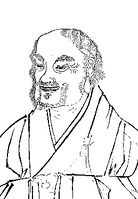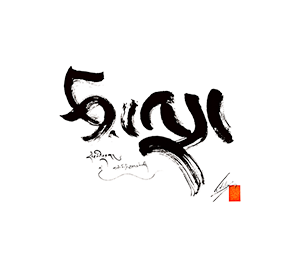Jingxi Zhanran: Difference between revisions
No edit summary |
No edit summary |
||
| Line 16: | Line 16: | ||
|ReligiousAffiliation=Tiantai | |ReligiousAffiliation=Tiantai | ||
|StudentOf=Xuanlang (673–754) | |StudentOf=Xuanlang (673–754) | ||
|BnwShortPersonBio=Jingxi Zhanran. (J. Keikei Tannen; K. Hyŏnggye Tamyŏn (711–782). Chinese monk who is the putative ninth patriarch of the T ia n t a i z o n g ; also known as Great | |||
Master Miaole (Sublime Bliss) and Dharma Master Jizhu (Lord | |||
of Exegesis). Zhanran was a native of Jingqi in present-day | |||
Jiangsu province. At age nineteen, Zhanran became a Student | |||
of the monk Xuanlang (673-754), who had revitalized the | |||
community on Mt. Tiantai. After Xuanlang’s death, Zhanran | |||
continued his efforts to unify the disparate regional centers of | |||
Tiantai learning under the school’s banner; for his efforts, | |||
Zhanran is remembered as one of the great revitalizers of the | |||
Tiantai tradition. A gifted exegete who composed numerous | |||
commentaries on the treatises of T ia n t a i Z h iy i, Zhanran | |||
established Zhiyi’s M o h e z h i g u a n , F a h u a x u a n y i, and F a h u a | |||
w e n ju as the three central texts of the Tiantai exegetical | |||
tradition. His commentary on the Mohe zhiguan, the M ü h e | |||
z h ig u a n FUXING ZHUANHONG j u f , is the first work to correlate | |||
z h ig u a n (calmness and insight) practice as outlined by Zhiyi | |||
with the teachings of the S a d d f ia r m a p u n d a r Ik a s ü t r a (“Lotus | |||
Sütra”), the central scripture of the Tiantai tradition. In his | |||
J in g a n g Pi (“Adamantine Scalpel”), Zhanran argued in favor | |||
of the controversial proposition that insentient beings also | |||
possess the buddha-nature (f o x in g ). Zhanran’s interpretation | |||
of Tiantai doctrine and the distinction he drew between | |||
his own tradition and the rival schools of the H u a y a n z o n g | |||
and C h a n z o n g set the stage for the internal Tiantai debates | |||
during the Song dynasty between its on-mountain (shanjia) and | |||
off-mountain (shanwai) branches (see S h a n jia S h a n w a i). | |||
Zhanran lectured at various monasteries throughout the country and was later invited by emperors Xuanzong (r. 712-756), | |||
Suzong (r. 756-762), and Daizong (r. 762-779) to lecture | |||
at court, before retiring to the monastery Guoqingsi on | |||
Mt. Tiantai. | |||
|IsInGyatsa=No | |IsInGyatsa=No | ||
}} | }} | ||
Revision as of 13:59, 4 February 2020
| PersonType | Category:Classical Chinese Authors Category:Ordained (Monks and Nuns) |
|---|---|
| MainNamePhon | Jingxi Zhanran |
| MainNameChi | 荊溪湛然 |
| AltNamesOther | Qi (戚) · Jingqi 荊溪 · Great Master Miaole (Sublime Bliss) · Dharma Master Jizhu (Lord of Exegesis) |
| YearBirth | 711 |
| YearDeath | 782 |
| BornIn | Jingqi, (present-day Jiangsu province) |
| ReligiousAffiliation | Tiantai |
| StudentOf | Xuanlang (673–754) |
| IsInGyatsa | No |
| BnwShortPersonBio | Jingxi Zhanran. (J. Keikei Tannen; K. Hyŏnggye Tamyŏn (711–782). Chinese monk who is the putative ninth patriarch of the T ia n t a i z o n g ; also known as Great
Master Miaole (Sublime Bliss) and Dharma Master Jizhu (Lord of Exegesis). Zhanran was a native of Jingqi in present-day Jiangsu province. At age nineteen, Zhanran became a Student of the monk Xuanlang (673-754), who had revitalized the community on Mt. Tiantai. After Xuanlang’s death, Zhanran continued his efforts to unify the disparate regional centers of Tiantai learning under the school’s banner; for his efforts, Zhanran is remembered as one of the great revitalizers of the Tiantai tradition. A gifted exegete who composed numerous commentaries on the treatises of T ia n t a i Z h iy i, Zhanran established Zhiyi’s M o h e z h i g u a n , F a h u a x u a n y i, and F a h u a w e n ju as the three central texts of the Tiantai exegetical tradition. His commentary on the Mohe zhiguan, the M ü h e z h ig u a n FUXING ZHUANHONG j u f , is the first work to correlate z h ig u a n (calmness and insight) practice as outlined by Zhiyi with the teachings of the S a d d f ia r m a p u n d a r Ik a s ü t r a (“Lotus Sütra”), the central scripture of the Tiantai tradition. In his J in g a n g Pi (“Adamantine Scalpel”), Zhanran argued in favor of the controversial proposition that insentient beings also possess the buddha-nature (f o x in g ). Zhanran’s interpretation of Tiantai doctrine and the distinction he drew between his own tradition and the rival schools of the H u a y a n z o n g and C h a n z o n g set the stage for the internal Tiantai debates during the Song dynasty between its on-mountain (shanjia) and off-mountain (shanwai) branches (see S h a n jia S h a n w a i). Zhanran lectured at various monasteries throughout the country and was later invited by emperors Xuanzong (r. 712-756), Suzong (r. 756-762), and Daizong (r. 762-779) to lecture at court, before retiring to the monastery Guoqingsi on Mt. Tiantai. |
| Other wikis |
If the page does not yet exist on the remote wiki, you can paste the tag |

